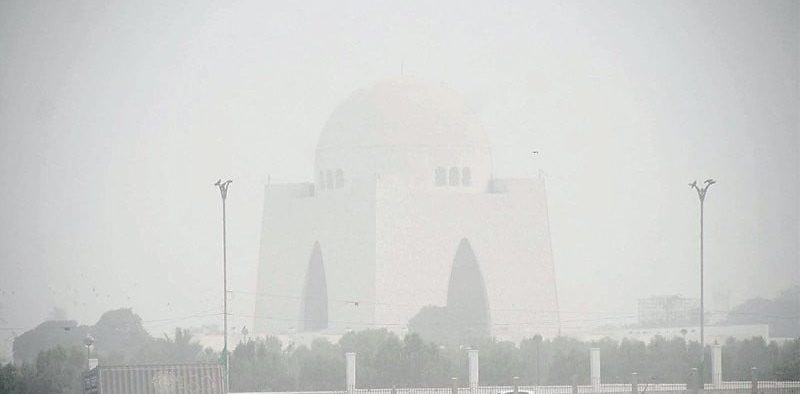How Pakistan managed to secure the coveted second place among nations with the poorest air quality

According to environmentalists, Pakistan’s ranking as the second-worst country in the world for air quality is a sad example of government incompetence and irresponsibility.
According to a new analysis by Swiss monitor IQAir, Bangladesh, Pakistan, and India were the three nations with the worst air quality globally in 2023. This report paints a dire image of South Asia’s air quality.
The World Health Organization recommends 5 micrograms of PM2.5, or airborne particles known to cause lung harm. The average concentration of PM2.5 in Pakistan increased from 70.9 to 73.7 micrograms and remained considerably higher than that.
India came in third place with 54.4 micrograms, followed by Bangladesh with 79.9 micrograms.
In 2023, Lahore ranked sixth in terms of pollution, behind Begusarai, Guwahati, Delhi, and Mullanpur in India.
Other significant Pakistani cities with poor air quality included Islamabad, which rose from 17th to 9th place on the list of the world’s most polluted capitals, and Faisalabad, Peshawar, Rawalpindi, Karachi, and Karachi.
Environmentalists mention a number of significant contributing reasons, including uncontrolled urbanization, deforestation, rising solid waste creation, industry and vehicle emissions, and population migration towards large cities.
Environmentalist Hamid Sarfraz, who lives in Islamabad, believes that persistent “institutional and behavioral failures” are to blame for the state of affairs.
“It’s a complex issue that calls for political will and capacity-building to put environmental legislation into effect. Sadly, neither of them has been up to par,” he told Anadolu.
Nearly all of the main causes of air pollution in Pakistan are covered by current legislation, but he said that government agencies are ill-equipped to put them into practice.
“More staff and equipment for environmental protection agencies is the most important need. Second, he stated, there has to be institutional cooperation across various government ministries.
He gave the example of how environmental protection organizations are unable to handle the problem of smoke-emitting automobiles, which continue to be a significant source of pollution in large cities, and how traffic police typically do little about it.
Therefore, if these two agencies work together, we can significantly reduce vehicle emissions,” he continued.
Go eco-friendly
According to estimates made by the Pakistan Air Quality Initiative using the most recent data, the nation’s life expectancy is being shortened by 4.4 years due to dangerous air quality.
In August of last year, the Energy Policy Institute at the University of Chicago released a paper stating that inhabitants of Lahore, Peshawar, Kasur, and Sheikhupura may have a minimum seven-year reduction in life expectancy due to rising air pollution.
Shabina Faraz, an environmental expert based in Karachi, believes that one of the biggest causes of the issue is still the nation’s “hellish” public transportation system.
“The main causes are pollution from industry and transportation. Vehicle emissions are still not improving, despite the fact that some industries—particularly those focused on exports—are beginning to make some progress, she told Anadolu.
She recommended that the government concentrate on “green public transport systems” in large cities as a stopgap solution to lessen the quantity of automobiles, particularly the “uncountable” amount of motorcycles.
“Smart sustainable cities” are the only way to proceed in the long run, she continued.
She emphasized the necessity for appropriate dump sites in relation to the solid waste management issue.
Although Pakistan produces less solid garbage than industrialized nations, it is woefully behind in terms of its ability to handle this waste, the official stated.
Sarfraz supported her opinions, stating that in addition to focusing on lowering industrial waste, authorities could also consider offering tax breaks as a possible motivator.
Agriculture and forests lost to housing
Pakistan’s woods and agricultural fields are being swiftly consumed by an increasing housing shortage, experts warn. This will have a domino impact on the environment and the nation’s food security.
Both large and small cities are experiencing a development frenzy, with woods, trees, and green spaces usually suffering the most.
According to official statistics, Pakistan’s entire area covered by forests is less than 5%, and an additional 1.5% of these woods are lost annually.
Although the ambitious “Green Pakistan Initiative” unveiled by Prime Minister Shehbaz Sharif aims to improve the declining forest cover, its effects will not be felt for years.
Particularly in Punjab and Sindh provinces, which are regarded as the nation’s two primary breadbaskets, vast tracts of land in both big and small towns have already been transformed into concrete jungles due to the housing demands of Pakistan’s rapidly expanding population, which is officially just short of 242 million.
Thousands of farmers have had their farmlands stolen by real estate developers, leaving large cities like Karachi, Lahore, and Islamabad surrounded by concrete buildings and bursting at the seams.
Shaukat Ali Chadhar, head of the Kisan Board of Pakistan, an agricultural advisory and research organization, estimates that 20–30% of Punjab’s rich land, which provides for 65% of Pakistan’s overall food needs, has been used for industry or housing.
According to him, 60% of agricultural land in Gujrat and 70% of agricultural land in Lahore alone have been turned into residential and commercial buildings.
He said that 30–40% of the fertile land in other farm areas in central Punjab, such Faisalabad, Gujranwala, Sheikhupura, and Kasur, has been sold to real estate developers and businesspeople.
In southern Punjab and northern Sindh, which together produce more than half of Pakistan’s wheat, sugarcane, and cotton, the land-holding ratio is still enough, according to Chadhar.

I am a dedicated student currently in my seventh semester, pursuing a degree in International Relations. Alongside my academic pursuits, I am actively engaged in the professional field as a content writer at the Rangeinn website.









